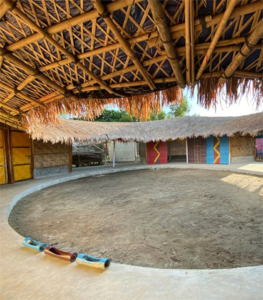Rohingya refugee women benefit from ‘safe space’
Having fled deadly violence in Myanmar’s Rakhine state three years ago, over a million Rohingya refugees still live in sprawling camps in Bangladesh. Despite repatriation attempts, the refugees are yet to return home.
The camps at, Cox’s Bazar, are home to around almost a million Rohingya refugees who fled from Myanmar.
 And the global COVID-19 pandemic has made the situation of the Rohingya, and especially the women, even more precarious.
And the global COVID-19 pandemic has made the situation of the Rohingya, and especially the women, even more precarious.
But despite the impasse, young Bangladeshi architect Rizvi Hassan is the driving force behind the construction of a safe space for Rohingya women and girls.
The ‘beyond survival’ safe space and community centre caters to a marginalized, vulnerable group of women and girls, at risk of gender-based violence.
Built by the Rohingyas themselves, the centre provides counselling and training to the women and girls, as part of a project by Bangladeshi NGO BRAC and the UN Children’s Fund (UNICEF).
“I grew up in Dhaka, the capital city of Bangladesh. While I was growing up, I had an interest in art and science and, later, my sister helped me to discover architecture as a field to explore both interests at the same time. And as I started studying architecture, I found out it could be a lot more,” Mr Hassan told UN News.
“I worked for a contemporary architecture firm for a short while, until I realized I had to be involved in something that has more to offer. So, I started working with BRAC on documenting cyclone shelters in Cox’s Bazar, and I came to know others who were working in different sectors on the refugee context here,” he said.
“We started sharing ideas on what can be done and how we can contribute, and came up with few projects that we could collectively design. As we started working, other organisations became interested in collaborating,” Mr Rizvi said.
The Safe Space project came about when aid workers involved in gender-based violence discussions in the refugee camp in Cox’s Bazar reported that, based on their findings, the community needed a safe space for women and girls to receive psychosocial support, skill training etc.
“We decided to create a building that provides a vibrant interior space and the rooms which separates it from the outside creating a screen itself. The oval shape, with series of columns, are considered to withstand strong winds, in a cyclone-prone area,” Mr Rizvi said.
“I wanted to make an impact on the lives of marginalized people, so I love doing this work. On this particular project, we received very positive feedback from the refugees, NGOs and the host population. It has become so popular that members of the local Bangladesh community also wanted to use the facility,” he said.
At the moment 80 per cent of the beneficiaries of the project are Rohingyas and 20 per cent are local Bangladeshi women and girls.
“Initially when we began the project, the local community and the refugees assumed we were building a football stadium! Our workers could not understand what we were trying to achieve, and we would draw curious crowds,” Mr Rizvi said.
“When the form began to take shape, people were excited, and the men were keen to use the facility for themselves. But when we explained to them that this was for women and girls, they were quite responsive: they informed their wives and daughters about the facility, and encouraged them to enroll,” he told UN News.












